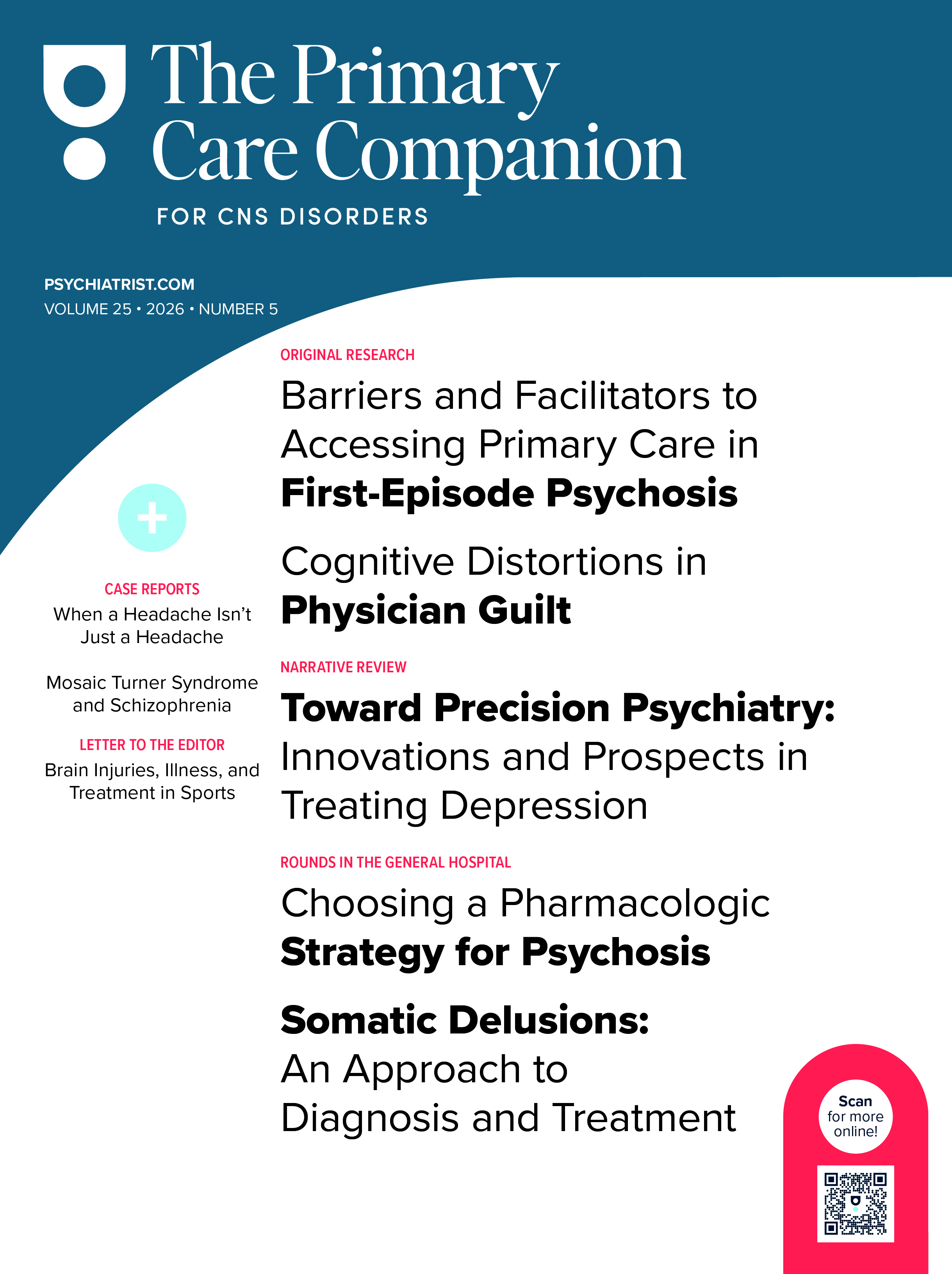Benzodiazepine-induced neurologic dysfunction (BIND) is a newly described condition involving persistent neurological and psychological symptoms following benzodiazepine taper or discontinuation.1 Unlike acute withdrawal, BIND symptoms can last for months to years and are believed to reflect long-term γ-aminobutyric acid (GABA)-A receptor neuroadaptation and neurotoxicity.1–3 While the risks of benzodiazepine use disorder (BUD) are well known, BIND remains an emerging diagnosis and is therefore underrecognized in primary care settings, wherein benzodiazepine prescribing is frequently managed. This case illustrates how BIND and BUD can coexist, emphasizing the importance of distinguishing between them to guide diagnosis and management.
Case Report
A 57-year-old man with alcohol use disorder (AUD) and unspecified depressive and anxiety disorders presented to the hospital with uncontrollable anxiety. Two weeks prior, he entered a 30-day residential program for AUD but left after 10 days when his long-term benzodiazepine regimen was discontinued, and he was medically withdrawn with phenobarbital. He remained abstinent from alcohol after leaving the residential program.
The patient reported a 40-year history of uninterrupted high-dose benzodiazepine use, at one point up to 12 mg of lorazepam daily and, most recently, clonazepam 1 mg 4 times daily. Despite extensive psychiatric treatment for depression and anxiety, including numerous antidepressants, second-generation antipsychotics, esketamine, transcranial magnetic stimulation, and electroconvulsive therapy, benzodiazepines remained his only consistent intervention.
Upon evaluation, he described ongoing fatigue, cognitive slowing (“brain fog”), overwhelming emotional distress, and panic that persisted since benzodiazepine discontinuation. He repeatedly requested reinstatement of benzodiazepines, demonstrating preoccupation and craving. Inconsistent with his self-report, on clinical evaluation, he appeared calm, without tremor, diaphoresis, or autonomic instability, with all vital signs stable and within normal limits. Routine laboratory studies were unremarkable. His blood alcohol level was negative and urine drug screen positive only for barbiturates, which was attributed to prior receipt of phenobarbital.
The patient was admitted to the general medical floor for observation. To cover potential subacute GABAergic withdrawal from a receptor standpoint, he was treated with our hospital’s protocolized phenobarbital taper. Given his coexisting AUD and signs of both BIND and BUD, benzodiazepine reinitiation was not pursued. He was discharged on hospital day 4 in stable condition with plans to follow up at an addiction psychiatry bridge clinic to establish outpatient care.
Discussion
While acute benzodiazepine withdrawal is well characterized, typically emerging within days and resolving in under 2 weeks,4,5 some patients experience prolonged symptoms such as fatigue, impaired concentration, and anxiety that persist well past this timeframe.1 Historically, these symptoms were grouped under the umbrella term of postacute withdrawal syndrome. However, BIND has emerged as a more specific framework for benzodiazepine-related neuroadaptation and neurotoxicity.1,3,6 These symptoms, often attributed to rebound anxiety or somatic symptom amplification, are now increasingly recognized as BIND.
This patient met the Diagnostic and Statistical Manual of Mental Disorders, Fifth Edition, criteria for sedative-hypnotic use disorder, benzodiazepine type, based on tolerance, withdrawal, and craving. However, his symptoms persisted beyond the acute withdrawal period, supporting a co-occurring diagnosis of BIND. While BUD demonstrates compulsive use and impaired control, BIND is characterized by neurological sequelae following long-term use and discontinuation.1,3
This distinction is clinically meaningful in that BIND and BUD can overlap but require different responses. For instance, solely treating substance use may overlook ongoing neurologic dysfunction that persists independent of active use. Primary care providers often manage both prescribing and discontinuation and are uniquely positioned to recognize this pattern and offer support.5
Benzodiazepines remain among the most prescribed psychotropic medications, with data from 2015 to 2016 showing that over 10% of adults in the United States received a prescription.7 A significant portion progresses to chronic use, and a subset develops symptoms that persist beyond initial withdrawal.1,5 BIND describes these lasting neurologic symptoms, such as distractibility, anxiety, and cognitive slowing, which are believed to result from lasting changes in GABA-A receptor function.1–3
Currently, there are no established treatment guidelines for BIND. Phenobarbital was used in this case to mitigate potential residual GABAergic withdrawal,2,8,9 but it is not a known treatment for BIND. While gradual benzodiazepine tapers are one suggested method to reduce the risk of persistent symptoms,5,10,11 this was avoided in our case because the patient had already been off benzodiazepines for 2 weeks, and resuming them was considered high risk in the context of co-occurring BUD and AUD. Instead, our management involved symptom validation and patient education as harm-reduction strategies without reintroducing benzodiazepines. Some individuals may also benefit from online support groups for patients recovering from chronic benzodiazepine use, and such resources should be provided to patients.12
Conclusion
BIND is a recently recognized and likely underdiagnosed condition that can emerge following benzodiazepine cessation, even in patients with concurrent BUD. Primary care providers are central in managing long-term benzodiazepine use and discontinuation and play a critical role in identifying and validating these symptoms. Differentiating BIND from acute withdrawal or BUD is essential for appropriate patient counseling and long-term care planning. Persistent symptoms following benzodiazepine discontinuation should prompt consideration of BIND as a distinct clinical entity.
Article Information
Published Online: November 27, 2025. https://doi.org/10.4088/PCC.25cr04026
© 2025 Physicians Postgraduate Press, Inc.
Prim Care Companion CNS Disord 2025;27(6):25cr04026
Submitted: June 17, 2025; accepted August 26, 2025.
To Cite: Krohn DM, Balasanova AA. A case of benzodiazepine-induced neurologic dysfunction following chronic use. Prim Care Companion CNS Disord 2025;27(6):25cr04026.
Author Affiliations: College of Medicine, University of Nebraska Medical Center, Omaha, Nebraska (Krohn); Department of Psychiatry, University of Nebraska Medical Center, Omaha, Nebraska (Balasanova).
Corresponding Author: Alëna A. Balasanova, MD, Department of Psychiatry, Poynter Hall 5th Floor, University of Nebraska Medical Center, 985578 Nebraska Medical Center, Omaha, NE 68198-5578 ([email protected]).
Relevant Financial Relationships: None.
Funding/Support: None.
Acknowledgement: The authors thank Nolan Marshall, BS (College of Medicine, University of Nebraska Medical Center, Omaha, Nebraska), for his contributions to the case report. Mr Marshall has no relevant financial relationships to disclose.
Patient Consent: Consent was received from the patient to publish the case report, and information has been de-identified to protect patient anonymity.
References (12)

- Ritvo AD, Foster DE, Huff C, et al. Long-term consequences of benzodiazepine-induced neurological dysfunction: a survey. PLoS One. 2023;18(6):e0285584. PubMed CrossRef
- Ashton HC. Benzodiazepines: How They Work and How to Withdraw (The Ashton Manual). 31. Institute of Neuroscience, Newcastle University; 2019:80.
- Huff C, Finlayson AJR, Foster DE, et al. Enduring neurological sequelae of benzodiazepine use: an internet survey. Ther Adv Psychopharmacol. 2023;13:20451253221145561. PubMed CrossRef
- Pétursson H. The benzodiazepine withdrawal syndrome. Addiction. 1994;89(11):1455–1459. PubMed
- Hauck TS, Rochon S, Bahra P, et al. Outpatient treatment of chronic designer benzodiazepine use: a case report. J Addict Med. 2022;16(2):e137–e139. PubMed CrossRef
- Peng L, Lawrence D, Levander XA. Challenges of diagnosing and managing designer benzodiazepine dependence and withdrawal: a case report. J Addict Med. 2022;16(2):249–251. PubMed CrossRef
- Maust DT, Lin LA, Blow FC. Benzodiazepine use and misuse among adults in the United States. Psychiatr Serv. 2019;70(2):97–106. PubMed CrossRef
- Kawasaki SS, Jacapraro JS, Rastegar DA. Safety and effectiveness of a fixed-dose phenobarbital protocol for inpatient benzodiazepine detoxification. J Subst Abuse Treat. 2012;43(3):331–334. PubMed CrossRef
- Messenger JC, Hakimi E, Vercollone L. The use of a single dose of phenobarbital for inpatient management of benzodiazepine withdrawal: a case report. J Addict Med. 2023;17(2):230–232. PubMed
- Alexander B, Perry PJ. Detoxification from benzodiazepines: schedules and strategies. J Subst Abuse Treat. 1991;8(1–2):9–17. PubMed CrossRef
- World Health Organization. Clinical Guidelines for Withdrawal Management and Treatment of Drug Dependence in Closed Settings. World Health Organization; 2009:41–42.
- BenzoBuddies. A community of support for those who wish to withdraw from benzodiazepines. Accessed June 5, 2025. https://www.benzobuddies.org/
Please sign in or purchase this PDF for $40.





